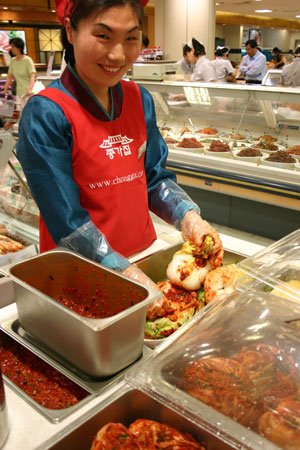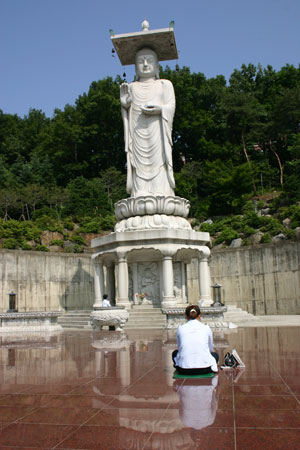SEOUL - SEOUL - This has always been the Rodney Dangerfield of Asian cities - it never gets any respect. This industrial giant has always taken a back seat to Asia’s other major cities. That, despite the fact it has just as many temples as Tokyo ... just as many lovely parks as Singapore ... just as many handsome boulevards as Beijing ... just as many tall buildings as Hong Kong ... just as many diverse restaurants as Shanghai ... and just as many (knockoff) shopping districts.
But in recent years, Seoul’s image has changed. In fact, many people consider this to be the hottest city in Asia right now. Seoul has become the new economic engine of Asia and draws hundreds of thousands of business people here each year. Interestingly, many return with their families to enjoy Seoul’s historic attractions, and wonderful shopping and entertainment districts found on its magical old streets.
"People are surprised to find Seoul is just as beautiful and vibrant as other Asian cities," Kim Lee, a local guide, told us.
“Maybe we don’t brag about what we have but I am very proud of our capital.”
And well she should be. This city of about 10 million may be the best kept secret in this part of the world. It certainly has as many tourist attractions as other major Asian centers plus a number of things that make it unique.
Like kimchi, the spicy Korean side dish that accompanies every meal (yes, even breakfast) and is so potent most airlines won’t allow it aboard flights leaving Seoul.
“We will try kimchi later,” Kim promised, “but first we must hurry to see the National Folk Museum.”
The museum is where the origins of Seoul are presented and offers great insight into Korean history and traditions. It sits on the shores of the Han River, the waterway that splits Seoul into north and south districts, and consists of one main pavilion where hundreds of ancient artifacts are exhibited.


Left: Kimchi is the most popular food in Korea. Right: Seoul has many temples dedicated to Bhudda.
One of the first exhibits visitors to the museum see is a giant mockup depicting what Seoul looked like when it was settled during the Bronze Age. A most interesting exhibit is the one that reveals Koreans are descendants of the Mongolian people and that the country’s phonetic language is much easier to learn than other Asian dialects. A high speed computer will even help you find the Korean characters that make up your name.
The museum examines the origins of kimchi, the vegetable dish fermented in chili powder and other spices and then stored in large ceramic pots for anywhere from two weeks to two years.
You either like kimchi or you hate it. However, by the end of a visit, most people learn to tolerate it. Every department store in Seoul has kimchi chefs who offer up a variety of dishes spiced with the cabbage based product.
The pots used to ferment the cabbage are from the same designs used for thousands of years. What a lot of people don’t know is that Korea actually shares a 5,000 year history with China, and that includes pottery making.
In fact, Koreans were so good at pottery making that the Japanese invaded this land in the 15th century and kidnapped many of the great pottery masters so it could compete with China.
Speaking of culture, no visit to Seoul would be complete without a stop at one of the city's famed cultural shows, where the traditional music and dance of Korea are performed by artists decked out in colorful native costumes.
The Korea House Theatre offers the best show. Visitors there can enjoy a traditional meal prior to the exhibition, which runs about an hour. The female fan dancers and males performing the samulnori, a mix of dance and acrobatics, are the real show stoppers at Korea House.
Seoul is a city living in two worlds. In one, the great ancient buildings used during the country’s legendary dynasties are showcased while in the other, the modern glass and steel towers that now make this one of the most advanced societies in the world are front and centre.
One of the best examples of Seoul’s past is Changdeokgung Palace, a regal compound that dates back to 1395 and rivals Beijing’s Forbidden City in size. In fact, Changdeokgung actually looks bigger than the Chinese landmark.
“That’s because Korean palaces are raised while the Chinese kept theirs low to the ground,” said Kim.
The winged-roofed buildings scattered about the palace grounds, where once 1,000 people lived, are much cheerier than their Chinese and Japanese counterparts, thanks mostly to the bright colors they are painted. When the Shilla Dynasty occupied this fortress, over 200 buildings stood here but now only a few remain.
Another great example of Seoul’s past is the impressive Bongeunsa Temple, built in 794 AD during the reign of King Wonseong of the Shilla Dynasty. It's one of the largest Buddha statues in overlooking the new Seoul that has risen on the city’s south bank.the country and stands. The temple grounds are sacred and people use them to escape the hustle and bustle happening on the streets surrounding it.
The city’s south side, known as Apgujeong, is where the high end fashion shops and large indoor malls can be found, tucked between the forest of office towers that have sprouted up in the last 10 years. Here is where shoppers find Rodeo St., which, thanks to the designer fashion stores that line the street, rivals its California cousin - Rodeo Drive.
What really makes Seoul a shopping Mecca, though, are the knockoff shops found in bustling Dongdaemun Market. From small stalls not much bigger than closets, vendors try to sell you goods bearing famous designer labels, none of which are real. However, what makes the market so famous is that the quality of the “fakes” sold here come closest to the real things.
But knockoff markets are sprouting up everywhere, even on New York City street corners, so getting a fake Gucci bag isn’t the exciting accomplishment it once was.
What is thrilling about Seoul, though, are the incredible traditional items that one can buy on old narrow streets like Insadong. The famous street – even Queen Elizabeth asked to shop there when she visited Seoul – is where artisans still make traditional masks using techniques passed down through generations. The area is also famous for its restaurants, where traditional meals are enjoyed in ancient buildings that once served as homes.
Seoul is a garden city blessed with several amazing parks, including Samcheong Park, Seodaemun Independence Park and Namsan Park, all located on the north side of the Han. Namsan Park is the most impressive and home to the mighty Seoul Tower, a communications behemoth from which you get stunning views of the city skyline and surrounding mountains. There’s also a bird sanctuary located in the slow moving Han River.
Twenty six bridges connect the north and south sides of the city, home to over 20 universities and some of the biggest names in the business world - Samsung, Hyundai and LG electronics, just to name a few.
In less than 20 years, Seoul has played host to two of the world’s largest events, the 1988 Summer Olympics and the 2002 World Cup of soccer. On each occasion, visitors left with good impressions of a city that deserves a lot of respect.
Information
- The National Folk Museum is located at Euljiro 1, Jung-gu, Seoul.
- A great place to stay in Seoul is the Shilla Hotel. It's located at 202 Jangchung Dong 2 Ga, Jung-gu. For information about rates, go to www.fivestaralliance.com/Shilla_Seoul
- Getting around Seoul is easy thanks to the city's eight major subway lines which are spotless and very efficient.